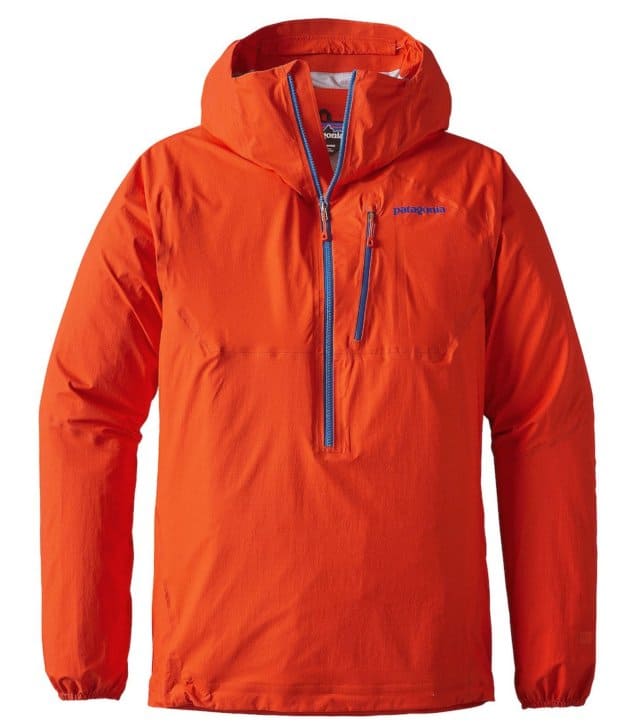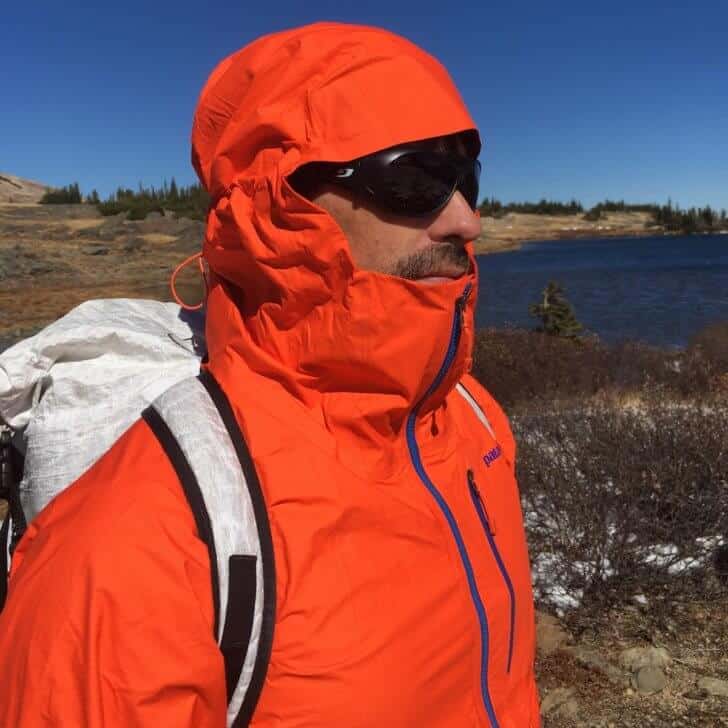Introduction
The Patagonia M10 Anorak is a minimally-featured three-layer waterproof/breathable hardshell jacket targeted primarily to alpine climbers. However, its minimalist design and light weight might appeal to some backpackers as well.
As for me, I’m particularly enamored by the Patagonia M10 Anorak’s fit, styling, durability, and breathability. The fact that exceptional durability and breathability can be packed into a 7 oz (198 g) waterproof jacket reflects the fact that apparel manufacturing technologies are still marching forward in a quest to meet our demands for ever-increasing performance-to-weight ratios.

Features
- Ultrasonically welded seams with narrow seam tape to reduce bulk and weight.
- Patterning eliminates shoulder and back seams to minimize failure points.
- Helmet-compatible hood with stiffened visor and single-pull drawcord adjustment.
- Anorak (pullover) style with deep front waterproof zipper for ventilation and easy on-off.
- Exterior left chest pocket with waterproof zipper.
- Single-pull drawcord hem.
- Fit type: “Slim.”
- Elasticized (non-adjustable) cuffs.
Specifications
Dimensions are based on a Men’s size Medium.
- Fabric: Patagonia-branded “H2No Performance Standard” 3-layer, 2-oz 12-denier 100% nylon ripstop with a waterproof/breathable barrier and a DWR (durable water repellent) finish.
- Zipper (neck): #5 water-resistant tooth zipper (17.5 in / 45 cm).
- Zipper (chest pocket): #3 water-resistant coil zipper (6 in / 15 cm).
- Center Back Length (rear): 27 in / 69 cm (from base of hood to bottom of waist hem);
- Chest Pocket Dimensions: 5.0+ x 7.5+ in (h x w) / 12.7+ x 19.1+ cm (h x w) – Pocket is trapezoidal in shape, dimensions represent the maximum size rectangle that can fit into the pocket.
- Width of stiffened brim in hood visor: 2.75 in / 7 cm.
- Weight (manufacturer’s claim): 7 oz / 198 g.
- Weight (actual measured weight): 7.2 oz / 204 g.
Review Context
I’ve recently immersed myself into the study of ultralight rain jackets after taking a hiatus from this product category for a few years. The biggest change that I’ve seen over the past five years is that the sub–8 oz jackets available today offer significantly higher “performance” (e.g., durability, breathability, and features) than ultralight jackets of yesteryear.
An ultralight backpacker might consider the following needs when shopping for an ultralight rain jacket:
- A fit voluminous enough to layer over puffy insulation.
- Enough durability to handle moderate bushwhacking or rock-scrambling.
- Enough breathability and ventilation to deal with an all-day rain in cold temperatures.
- Light enough in weight that the hiker won’t feel too bad about having the jacket sit in the bottom of their pack, unused, for the duration of a long hike in balmy weather.
That’s a tall order to fill, certainly.
Here’s how the Patagonia M10 Anorak addresses these issues.
Description of Field Testing
I’ve been testing this shell side by side with the Montane Minimus 777 Anorak, a 2014 Patagonia M10 full-zip jacket, and a ZPacks Challenger eVENT Jacket for the past several months in three key inclement weather contexts:
- Cold and wet conditions – fall packrafting on the Madison River in Montana with temperatures in the 30s to 40s, and heavy, sustained rain for up to six continuous hours.
- Dry and extremely windy conditions – fall hiking in the Snowy Mountains in Wyoming above the treeline at 11,000+ feet with temperatures in the 20s to 40s, low humidity, sunny weather, and winds steady at 15–30 mph and gusting to 50 mph.
- Extreme cold, high output – winter trail hiking and running in Montana and Wyoming at 6,000–8,000+ feet, most often below the treeline when temperatures are ranging from the single digits to 20s, with low to moderate humidity, and little or no wind.

My goals were to answer the questions surrounding the jacket’s comfort when used as a cold weather windshirt in dry conditions and as a rain shell in heavy, sustained rain. How the Patagonia M10 Anorak meets these goals is detailed in the Performance Assessment that follows.
Performance Assessment
My performance assessment of the Patagonia M10 Anorak addresses the following items:
- Finish quality
- Fit
- Hood
- Wrist cuffs
- Hem
- Zipper
- Durability
- Breathability and ventilation
- Weight and compressibility
Member Exclusive
A Premium or Unlimited Membership* is required to view the rest of this article.
* A Basic Membership is required to view Member Q&A events




Home › Forums › Patagonia M10 Anorak Review